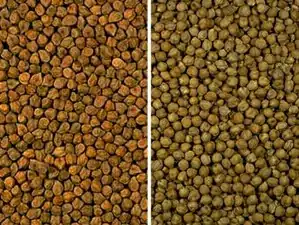
Cookbook | Recipes | Ingredients | Vegetable
| Legumes
Chickpeas are legumes used in the cuisines of South Asia, the Middle East, and the Mediterranean. They provide high-quality carbohydrates and protein, are recommended for diabetics, and are credited by some as the key to development of human civilization through agriculture.
There are two main types:
- Kabuli - European chickpeas, ceci, or garbanzo beans, are large, white chickpeas that are much used throughout southern Europe and the Middle East, but are also used in Indian cuisine for making dahls. These chickpeas are used as the basic ingredient in hoummus (hoummus means chickpea in Arabic), and are interchangeable with fava beans for making falafel. Chickpeas are ground finely to make chickpea flour.
- Desi - Bengal gram, chana, boont (Bihar), or kadalai (Tamil), are much more common in South Asian cuisine. Grinding raw chana to flour makes besan or gram flour whereas ground roasted chana makes Sattu. Sattu is the main filler of LITTI, a famous cuisine of Bihar.
Chana dal or channa dhal are split, usually also hulled (skinless) chickpeas used in dals. The term nearly always refers to the Desi, but sometimes also to the Kabuli - usually though, Kabuli dal are called Kabuli chana dal. In Tamil, chana dal is called kadalai parrappu. They are often cooked with a pinch of asafoetida to make them more easy to digest.
Cooking Dried Chickpeas
Dried chickpeas are fairly easy to prepare, if you allow enough time. They taste far better than the canned version. Dried chickpeas expand to at least twice their volume when cooked.
- Soak the chickpeas overnight in water. The next day they are ready to cook.
- Chop 2 stalks of celery for every cup of chickpeas (a cup is approximately a large handful) and put the drained chickpeas and celery into a pot. The chickpeas will continue to expand, so you should not fill the pot more than half full of the bean and celery mixture.
- Add water until the chickpeas are covered.
- Cook on medium for 2 hours. The cooking time is not an exact science; you will need to bite into a chickpea to see if it is fully cooked.
- Once the chickpeas are done, drain the cooking liquid. (Incidentally, the cooking liquid from chickpeas makes a wonderful stock called Cookbook:Aquafaba.)
- You can season with salt, pepper, and a dash of olive oil and vinegar if you would like to eat them plain, or they can be used in other recipes calling for canned chickpeas.
Cooking Chickpeas with a Pressure Cooker
If you have a pressure cooker, you can reduce the cooking time substantially.
Well-soaked chickpeas with enough water to cover them will cook to perfection at 15psi in 9 minutes, plus about 10 minutes to depressurise.
Dried chickpeas can also be cooked directly in a pressure cooker. Add approximately 3 times as much water as chickpeas, and add a small amount (~10-20ml) of oil to reduce foaming. Cooking time is 40 to 50 minutes.